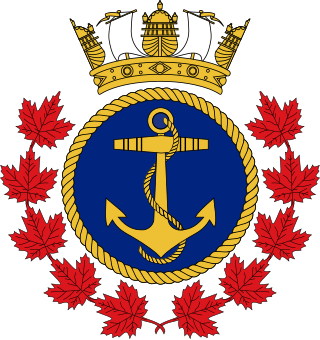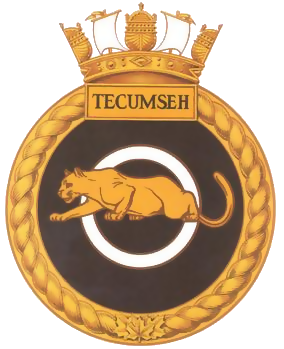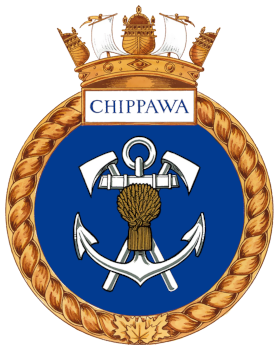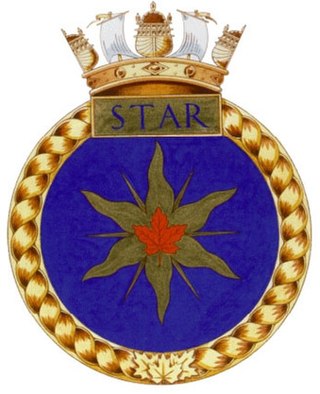
The Royal Canadian Navy is the naval force of Canada. The RCN is one of three environmental commands within the Canadian Armed Forces. As of 2023, the RCN operates 12 frigates, four attack submarines, 12 coastal defence vessels, eight patrol-class training vessels, two offshore patrol vessels, and several auxiliary vessels. The RCN consists of 8,400 Regular Force and 4,100 Primary Reserve sailors, supported by 3,800 civilians. Vice-Admiral Angus Topshee is the commander of the Royal Canadian Navy and chief of the Naval Staff.

The Royal Canadian Sea Cadets is a Canadian national youth program sponsored by the Canadian Armed Forces and the civilian Navy League of Canada. Administered by the Canadian Forces, the program is funded through the Department of National Defence, with the civilian partner providing support in the local community. Cadets are not members of the Canadian Armed Forces.

HMCS Discovery is a Royal Canadian Navy Reserve division and shore facility based in Vancouver, British Columbia, Canada. Created during World War II from the Vancouver Half Company of the Royal Naval Canadian Volunteer Reserve, it was used for recruitment and training, and provided almost 8,000 personnel during the war. It continued its training role after the war, and is also headquarters for several Reserve and Cadet units.

HMCS Tecumseh is a Canadian Forces Naval Reserve division (NRD) located in Calgary, Alberta. Dubbed a stone frigate, HMCS Tecumseh is a land-based naval training establishment crewed by part-time sailors and also serves as a local recruitment centre for the Royal Canadian Navy (RCN). It is one of 24 naval reserve divisions located in major cities across Canada.

HMCS Ontario was a Minotaur-class light cruiser built for the Royal Navy as HMS Minotaur (53), but transferred to the Royal Canadian Navy on completion and renamed Ontario.
Garrison St. John's is a Canadian Forces Garrison located in St. John's, Newfoundland and Labrador.
His Majesty's Canadian Ship (HMCS) Prevost is a Canadian Forces Naval Reserve Division (NRD) located in London, Ontario. Dubbed a stone frigate, HMCS Prevost is a land-based naval establishment for training part-time sailors as well as functioning as a local recruitment centre for the Royal Canadian Navy (RCN). Prevost reserve sailors serve on all classes of ship on both coasts and the Great Lakes and have served on many occasions overseas on UN and NATO tours of duty, along with harbour defence units.

HMCS Carleton is a Canadian Forces Naval Reserve Division (NRD) located in Ottawa, Ontario, Canada. Dubbed a stone frigate, HMCS Carleton is a land-based naval training establishment crewed by part-time sailors and also serves as a local recruitment centre for the Canadian Forces Naval Reserve. It is one of 24 naval reserve divisions located in major cities across Canada.

HMCS Chippawa is a Royal Canadian Navy Reserve Division (NRD) located in Winnipeg, Manitoba. Dubbed a stone frigate, HMCS Chippawa is a land-based naval establishment for part-time sailors as well as a local recruitment centre for the Royal Canadian Navy (RCN).

HMCS Donnacona is a Royal Canadian Navy reserve division located in Montreal, Quebec. Dubbed a stone frigate, HMCS Donnacona is a land-based naval establishment for training and recruitment primarily of part-time sailors for Canada's naval reserve.

HMCS Star is a Canadian Forces Naval Reserve Division (NRD) located in Hamilton, Ontario. Dubbed a stone frigate, HMCS Star is a land-based naval establishment for training part-time sailors as well as functioning as a local recruitment centre for the Royal Canadian Navy (RCN). The second oldest of 24 naval reserve divisions located in major cities across Canada, Star was stood up on 15 March 1923 as the Royal Canadian Naval Volunteer Reserve (RCNVR) Hamilton Half Company and then on 1 November 1941 as HMCS Star.

HMCS Malahat is a Royal Canadian Navy Reserve Division (NRD) located in Victoria, British Columbia. Dubbed a stone frigate, HMCS Malahat is a land-based naval training establishment for part-time sailors as well as a local recruitment centre for the Canadian Naval Reserve. It is one of 24 naval reserve divisions in major cities across Canada.

The Naval Reserve is the Primary Reserve component of the Royal Canadian Navy (RCN). The primary mission of the NAVRES is to force generate sailors and teams for Canadian Armed Forces (CAF) operations, including: domestic safety operations as well as security and defence missions, while at the same time supporting the Navy's efforts in connecting with Canadians through the maintenance of a broad national presence.

HMCS Unicorn is a Canadian Forces Naval Reserve division (NRD) located in Saskatoon, Saskatchewan. Dubbed a stone frigate, Unicorn is a land-based naval training establishment crewed by part-time sailors and also serves as a local recruitment centre for the Royal Canadian Navy (RCN). It is one of 24 naval reserve divisions located in major cities across Canada.

The Llewellyn-class minesweepers were a series of ten coastal minesweepers constructed for the Royal Canadian Navy during the Second World War. Based on the Admiralty type MMS-class minesweeper, the Llewellyn class were constructed of wood and used for the removal of magnetic influence mines. Two were built in Quebec, with the eight constructed on the Western Coast of Canada. Mostly used as guard ships during the war, only three of the ten remained in Royal Canadian Navy service following the war, with the last being discarded in 1957. Following naval service, vessels of the class ended up in commercial service, with some becoming fishing vessels, cargo ships and one a floating restaurant. Six of the ten ships were lost in commercial service.

HMCS Nonsuch is a naval reserve division (NRD) located in Edmonton, Alberta. Dubbed a stone frigate, HMCS Nonsuch is a land-based naval establishment for part-time sailors as well as a local recruitment centre for the Canadian Forces Naval Reserve. It is one of 24 naval reserve divisions located in major cities across Canada.

HMCS Hunter is a Canadian Forces Naval Reserve Division (NRD) located in Windsor, Ontario. Dubbed a stone frigate, HMCS Hunter is a land-based naval training establishment crewed by part-time sailors and also serves as a local recruitment centre for the Canadian Forces Naval Reserve. It is one of 24 naval reserve divisions located in major cities across Canada.

HMCS Brunswicker is a Canadian Forces Naval Reserve Division (NRD) located in Saint John, New Brunswick. Dubbed a stone frigate, HMCS Brunswicker is a land-based naval training establishment crewed by part-time sailors and also serves as a local recruitment centre for the Canadian Forces Naval Reserve and the Royal Canadian Navy (RCN). It is one of 24 naval reserve divisions located in major cities across Canada.
HMCS Radisson is a Canadian Forces Naval Reserve Division (NRD) located on Île Saint-Christophe in Trois-Rivières, Quebec. Dubbed a stone frigate, HMCS Radisson is a land-based naval training establishment crewed by part-time sailors and also serves as a local recruitment centre for the Canadian Forces Naval Reserve. It is one of 24 naval reserve divisions located in major cities across Canada.
HMCS Queen Charlotte is a Canadian Forces Naval Reserve Division (NRD) located in Charlottetown, Prince Edward Island. Dubbed a stone frigate, HMCS Queen Charlotte is a land-based naval training establishment crewed by part-time sailors and also serves as a local recruitment centre for the Royal Canadian Navy (RCN). It is one of 24 naval reserve divisions located in major cities across Canada.
















